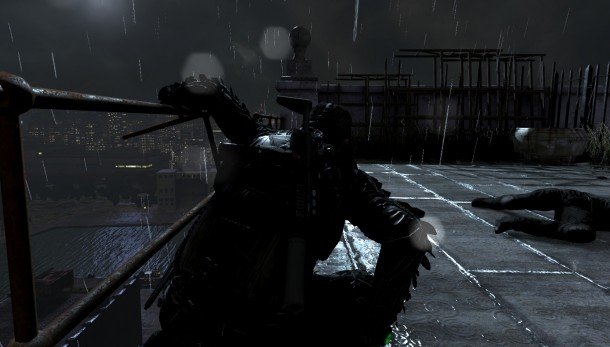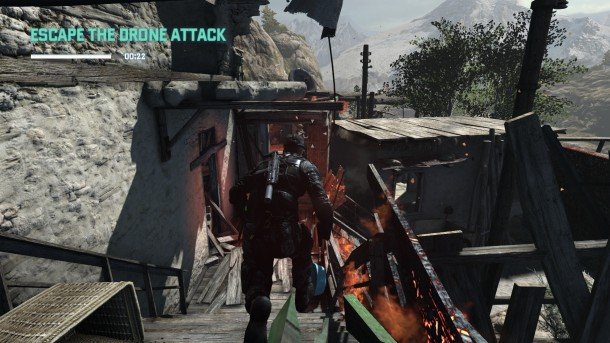Our Verdict
Wonky mission design and technical issues drag down a solid stealth game that still has enjoyable multiplayer.
PC Gamer's got your back
Splinter Cell: Blacklist is a stealth game of the robust, rule-based kind, where each environment is a puzzle waiting to be cracked. You slip snake cameras under doors or use sonar vision to get the lay of the land. Then, you pick a route and use the gadgets you've brought with you to eliminate each guard in order. Blacklist has more of old Splinter Cell in it than Conviction did, but it's not a perfect revival of the series.
It'd really like it if you saw it that way, however. Sam Fisher has been plucked out of retirement, shaved, given some moisturiser, and plonked in charge of Fourth Echelon, a younger and sexier take on the spy agency from the original games. 4E roams the world in Paladin, a spy plane that enables Sam and a gang of new and old sidekicks to breach international law wherever and whenever they please.
On a minute-to-minute basis, the level design is an issue. Having a range of gadgets to use means less if you don't need to use them at all, and Blacklist's linear series of arenas rarely need to be manipulated as carefully or on as large a scale as in Splinter Cell of old. 'Realistic' difficulty changes this somewhat, removing Conviction's 'mark and execute' feature – which allows you to tag groups of enemies for later elimination – as well as axing midmission resupply caches and reducing the usefulness of sonar goggles. Being forced to rely on your noisemakers and sticky cameras more is great, but it doesn't prevent environments from feeling narrow and stagey. When you come across a climbable pipe, you know that a developer somewhere expects you to climb it – and that it'll probably lead you conveniently over the head of that armoured guard you couldn't figure out how to get past.
The supremacy of certain gadgets accentuates the problem. Consider the crossbow. A mission or two will earn you the funding you need to pick up this silent weapon and all of its ammo types, enabling you to fill a single gadget slot with a device that can shoot EMP bolts, taser bolts, noisy bolts, and sleeping gas bolts that instantly wipe out gaggles of enemies all at once, difficulty level be damned. On multiple occasions in the campaign, Fisher will have to escape an area with a hostage under one arm. These sections force you to rely on whatever weapon you were holding when the sequence began. To help you out, you're assigned infinite ammo for no particular reason – and I stumbled into one wielding the crossbow with sleeping bolts. The result was a ridiculous charge down a riverside as Sam Fisher mercilessly ushered commando after commando into a deep and restful repose.

Awkward, hand-holdy sections like this are the game's other great weakness. There's the obligatory bit where you escape from a burning building, and an early mission begins with a sniper section where you must eliminate enemies in the right order to allow Fisher to progress. Logically, you might assume that if you screw up then the subsequent stealth section will become harder. Not so – you have to repeat it until you do it perfectly.
Optional side missions unlocked by speaking to Sam's crew are playable in solo and co-op modes and present you with open areas that promise to fix the campaign's problems. One set, where you're asked to clear areas of enemies before progressing, offers a good balance of stealth and action and rewards creativity. Another set, however, resets you to the start of the mission if you're ever detected. There's no checkpointing, and Blacklist has no mid-mission save system. This turns features that should be positive – like the guard patrols that vary from run to run – into crushing negatives. Flawless stealth is an exercise in gruelling trial-and-error.
Every mission in the game can be repeated for points, which are assigned based on your performance in one of three categories: Ghost, Panther,and Assault. Ghost means slipping by undetected and non-lethally subduing guards you can't avoid. Panther is similar but you're allowed to kill people, and Assault is for people who would rather be playing a shooter. But Blacklist leans on its scoring system to provide you with consequences for the way you choose to play: the main narrative doesn't respond to your choices at all. Lethal or non-lethal is a high-score decision, rendering toothless the infrequent moments when you're asked if you're willing to spare a life.
This is a Tom Clancy story, and therefore it is about some government people, their gadgets, and a series of politically motivated explosions whose grounding in real politics is conveniently woolly in the way that a flock of sheep resting at the bottom of a slippery slope is conveniently woolly. Fans of the genre will note that the principal threat is not an EMP, for once, but is something rather a lot like an EMP.

It's not a reboot, but I'm not sure why. About half of the Splinter Cell cast reprise their old roles, and the new Fisher is visibly and audibly 35-ish in a way that confuses the game's insistence that he's pushing 50. The performances are more dynamic in general, but I missed the heart Michael Ironside brought to Fisher. This is a heartless story, about unaccountable violent people doing unaccountable violent things.
The game has no central menu. When you begin the campaign for the first time you pick a difficulty level and launch directly into the lengthy opening cutscene, which is followed by a brief mission. It's sort of a tutorial, but it's skippable and most of the work of getting you up to speed is done once it's over.
Whenever you begin the game from this point on you load directly onto the airborne Paladin and conduct the rest of your business via the SMI, a massive onboard table computer. SMI means 'Sam's Magic iPad', if you were wondering.
It's magic because it provides whatever information the team needs to progress in the plot, whenever they need it. It's magic because it allows you to travel backwards in time to play older missions, a necessity of Blacklist's highscore-chasing metagame. And it's magic because it plugs Sam Fisher into the game's multiplayer, which is where Blacklist picks itself up out of mediocrity and claims a bit of magic for itself.
Spies vs mercenaries multiplayer makes a return, with a classic 2 vs 2 mode as well as 4 vs 4 incorporating upgrade trees and unlockable classes and everything else expected of a modern game. At its most basic, spies race to hack nodes that mercenaries have to defend – but a series of clever design decisions prevent it from feeling like any other type of capture point multiplayer. In order to stop a hack, mercenaries have to find the spy that started the process and kill them. This encourages the spies' allies to ambush guards, set traps, or simply try to be distracting.

Different maps emphasise different strategies. Hiding in the shadows is an option in some, while others place the spies in situations where direct confrontation is more likely. It's a much more organicfeeling marriage of game mechanics and level design than Blacklist manages in singleplayer. I enjoyed sprinting across a room with gunfire pinging at my heels, knowing that I was buying 20 seconds of respite for my hacker friend. There's a real sense of danger, and it's a world away from Sam Fisher trudging down a riverbed, putting men to sleep with his infinite ammo crossbow.
Two sets of tech problems are worth bearing in mind. The first is the controls: this is a game that was designed to be played with a pad, and its heavy use of context-sensitive actions and radial menus make keyboard and mouse play fiddly. The second problem is Uplay. Ubisoft's proprietary launcher is necessary even if you own the Steam version, and in my case it refused to allow me to connect to the game's online service until someone from Ubisoft fiddled with my account in order to fix it. Then, Uplay deleted all of my saves. I had luckily taken manual backups, but could only restore them by disabling cloud saving outright. I recommend you do the same, if only to avoid having the problem in the first place.
Splinter Cell: Blacklist is far from terrible, but it's not the classic that Chaos Theory was and it learns the wrong lessons from Conviction. That said, this is the strongest the series has ever been in multiplayer, and for that reason – and for the few missions where its stealth pedigree clicks into place – it's worth peeking into its darkened corners.
Wonky mission design and technical issues drag down a solid stealth game that still has enjoyable multiplayer.
Joining in 2011, Chris made his start with PC Gamer turning beautiful trees into magazines, first as a writer and later as deputy editor. Once PCG's reluctant MMO champion , his discovery of Dota 2 in 2012 led him to much darker, stranger places. In 2015, Chris became the editor of PC Gamer Pro, overseeing our online coverage of competitive gaming and esports. He left in 2017, and can be now found making games and recording the Crate & Crowbar podcast.



